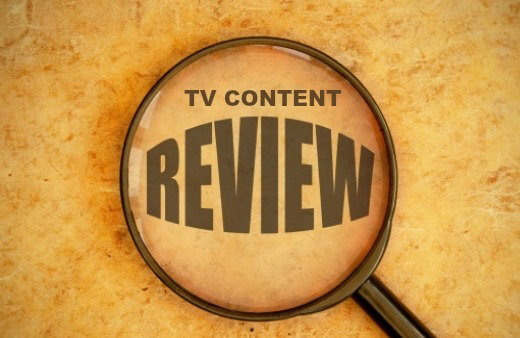How TV Content Review Works

The primary goal of television production is to produce content that entertains, engages, and enthralls the audience. However, broadcasters, networks, and producers must also account for the responsibility they have to protect the public interest. That means there are often other non-entertainment considerations that must be applied to TV shows that revolve around TV content review such as 1) compliance with the requirement to provide a rating under the TV Parental Guidance Ratings System and 2) the application of broadcast standards and practices guidelines covering content as it relates to any of the following: violence, sexual dialogue, depiction of sexual acts, adult language, sensitive themes, and the protection of sensitive audiences. Put simply, distribution channels comply with TV Ratings parental guidance rules and self-regulate their program content because of viewer and advertiser expectations, and because they want to avoid government regulation or penalty. So, as you can tell, there is nothing simple about the standards and practices process.
Who decides what a sensitive audience is? Who decides what words are offensive? How can television progress to the elusive “next level” if the networks cater to the most conservative societal mores and refuse, or worse – are afraid, to push the envelope? Looking back, we can now see that when the toilet was heard flushing in an episode of “All in the Family” in the 1970s it pushed the envelope of discomfort. Menopause, rape, and childbirth were also topics on this show that expanded the possibility of what could be on TV. However, at the time, these topics were taboo and shocking. As the head of Broadcast Standards and Practices for NBC Television in the eighties, I can only imagine the conversations (or perhaps shouting) that took place between the standards and practices team, the network, and the creators of this show. The reality is standards do change over time and currency of attitude toward content is needed to do a reasonable job as a content editor.
The advent and eventual proliferation of cable networks and pay TV services have definitely ushered in a more relaxed climate that has seen huge changes in the nature and levels of nudity, language, and violence that are deemed acceptable. Cultural changes have pushed the envelope on what people are not only willing to watch, but also demanding to watch. TV content review is an evolving landscape.
The expertise I developed at NBC is the reason Enteractive Solutions Group provides both standards and practices review and TV Ratings Guidance; these two services are connected – after all the standards and practices review impacts the TV Rating – but both are separate and distinct processes. Additionally, ESG has a long history of providing standards and practices compliance reviews for game shows to production companies and networks through our Sullivan Compliance Company subsidiary.
Any way you look at standards and practices or compliance, there is going to be a line drawn in the sand between the entities that want to remain unencumbered by rules and limits and the entities that want to make sure the completed project doesn’t defy the laws of decency. You can see why standards and practices reviews can often pit the more “creative” types against more conservative executives. It is no fun to be in the middle of that conversation!
This is the brilliance of having a standards and practices division or even better, an outside third-party standards and practices company. There is real value in having someone who can act as an objective editor, unburdened by the pride of authorship but mindful of the creative objectives, look at content and ask the questions that may need asking, like, “Should this period piece use a derogatory word to depict Asians during the 1950s?” or “Don’t you think showing less bum crack would suffice?”
At its core, the best application of standards and practices for entertainment programs recognizes that content standards need to be applied in a manner that allows for the production of the best possible television entertainment content. The most sensible approach to doing this is to first recognize that there is a wide range of audience sensitivities that often differ due to geography, demographics or gender. Additionally, the potential concerns of advertisers towards having their commercial messages in certain types of content and any potential concerns of the “distribution system” (be it TV Stations or Cable Affiliates) must be considered. The existence of professional “public interest” gadfly organizations further complicates the TV Standards environment. Finally, the legitimate concerns and requirements of the creative people who write, produce, and direct these programs must be considered. Good television depends highly on creativity and talent being able to properly exercise their creative vision. All of these competing interests must be considered and balanced in reaching program content decisions. Take it from me, it is not often easy to accommodate these various interests, but it is possible.
The best place to begin the standards and practices process is with script review if a script is available. Scripting is where sensitive content is often first discoverable. Working with the producers, standards, and practices notes are generated based on submitted scripts. The standards and practices function provide appropriate cautions and instructions to producers, based on the general guidelines that are determined in consultation with the distribution network. The goal is to foster a conversation about how the content will be recorded, including camera angles, duration, strong visuals, or coarse language, which will hopefully avoid a need to edit down the road. This is followed up by reviewing a “network cut” of the program and judging whether the standards and practices notes were taken and executed appropriately. Of course, this process is more of an art than a science, but in the best case, the production process and the TV content review and standards process are coordinated and conducted in a reasonable and collegial fashion. Again, in addition to issues related to the portrayal of violence, sexual content, and language, standards reviews will identify the inappropriate treatment of special interest groups and insensitive language and stereotypes to avoid public relations problems and audience offense. While there are not often clear bright lines on content review, except for truly offensive language, offensive or excessive nudity, and indecency, establishing mutual goals, trust, and understanding with the producers goes a long way toward an effective process.
The primary questions that must be asked and answered by all parties are, “Is this particular content or language reasonable and essential to drive character development or a story point?” and “Is the content presented in the most reasonable and necessary way?” At the end of the day, nobody – not even the standards and practices executive – wants a bland show. However, no one involved should think offending the public or advertisers by pushing the boundaries of decency is the only viable way to create an audience. Of course, being able to clearly state the concern over specific content or presentation and why its inclusion may not be essential to the story or character development is also essential to an effective process for standards review. In this regard, there is no substitute for the skills gained by long experience.
Enteractive Solutions Group, Inc. and its Sullivan Compliance Company subsidiary have long experience in providing third-party standards and practices review to such clients as NBC, ABC, Discovery Networks, Game Show Network, SONY Pictures Television, WGN, and many leading production entities. Mr. Gerson served as head of NBC’s Program Standards and Practices functions for over 15 years.

